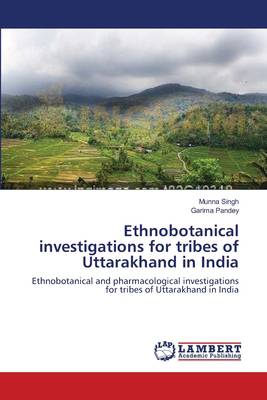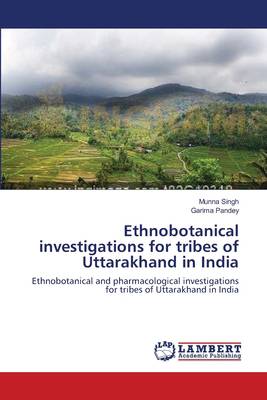
- Afhalen na 1 uur in een winkel met voorraad
- Gratis thuislevering in België vanaf € 30
- Ruim aanbod met 7 miljoen producten
- Afhalen na 1 uur in een winkel met voorraad
- Gratis thuislevering in België vanaf € 30
- Ruim aanbod met 7 miljoen producten
Zoeken
Ethnobotanical investigations for tribes of Uttarakhand in India
Ethnobotanical and pharmacological investigations for tribes of Uttarakhand in India
Munna Singh, Garima Pandey
Paperback | Engels
€ 114,45
+ 228 punten
Omschrijving
India has one of the largest tribal communities with about 68 million tribal people, belonging to 227 ethnic groups and 573 tribal communities living in different geographical locations throughout the country. WHO estimated that up to 84% of the world's population uses traditional medicine for primary health care for diverse health practices, approaches, knowledge and beliefs incorporating plants, animals and/or mineral based medicines, spiritual therapies, manual techniques and exercises applied in isolation or in combination to sustain well-beingness. Ethnobotanical informations extend vital opportunities for the discovery of new biodynamic compounds for modern medicare support. Thus, ethnobotanical approaches significantly promote modern pharmaceutical drugs based on primary informations. However, advances in modern civilization have impaired old customs, beliefs, habits and rich oral tradition of medicine, food etc. Hence, effective measures are to be taken to record and document the valuable knowledge bank of the tribes to improve their on-site socio-economy in years to come. The present book is based on ethnobotanical informations used by the Tharu and Buksa tribes in India.
Specificaties
Betrokkenen
- Auteur(s):
- Uitgeverij:
Inhoud
- Aantal bladzijden:
- 356
- Taal:
- Engels
Eigenschappen
- Productcode (EAN):
- 9783659475696
- Verschijningsdatum:
- 20/11/2013
- Uitvoering:
- Paperback
- Afmetingen:
- 150 mm x 220 mm
- Gewicht:
- 522 g

Alleen bij Standaard Boekhandel
+ 228 punten op je klantenkaart van Standaard Boekhandel
Beoordelingen
We publiceren alleen reviews die voldoen aan de voorwaarden voor reviews. Bekijk onze voorwaarden voor reviews.








